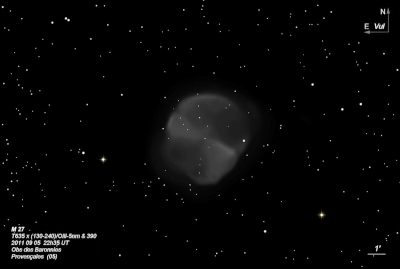Dumbbell Nebula
Dumbbell Nebula

15x50 IS binoculars (multiple dates): easily the most prominent planetary visible in binoculars.
Charles Messier discovered M27 = NGC 6853 = h2060 on 12 July 1764. This was the first planetary nebula discovered. Caroline Herschel independently found it on 30 Sep 1782, her second night of sweeping. William Herschel reported "My sister discovered this nebula this evening in sweeping for comets; on comparing its place with Messier's nebulae we find it is his 27. It is very curious with a compound piece; the shape of it though oval as M. [Messier] calls it, is rather divided in two; it is situated among a number of small stars, but with this compound piece no star is visible in it. I can only make it bear 278. It vanishes with higher powers on account of its feeble light. With 278 the division between the two patches is stronger, because the intermediate faint light vanishes more." This discovery may have spurred WH to search for new nebulae.
On 19 Jul 1784, William Herschel recorded "The nebula in Vulpecula I suppose to be a double stratum of stars of a very great extent. The ends next to us are not only resolvable nebulosity, but I really do see very many of the stars mixt with the resolvable nebulosity; farther on the nebulosity is but barely resolvable and ends at last in milky whitishness of the same appearance as that in Orion. The idea I form of the shape of the nebula is ...[diagram follows]."
Lord Rosse's sketch from 21 Sep 1843 with his 36" was published in his 1844 PTRAS paper. He noted "Cannot say positively whether resolvable, but see through it an immense number of stars apparently united with nebulous matter. If they are stars seen through the neb and unconnected with it, it is strange they should be so much more numerous than in the adjoining part of the heavens." George Johnstone Stoney's sketch (started on 9 Sep, finished on the 16th) was published in the 1850 PT paper (figure 17). Bindon Stoney's sketch, with several superimposed and nearby stars, was based on micrometrical measurements and included in the 1861 monograph (figure 43). On 29 Aug 1854 during a return to Birr Castle, George Johnstone Stoney wrote a long note: "Both Dr. Robinson and I agreed that the beard of faint nebulosity extended farther down [sp?] than in my brother's drawing..."
As far as the nickname "Dumbbell" nebula, John Herschel wrote on 24 Aug 1827 "A most extraordinary object; vB; an unresolved nebula, shaped something like an hour-glass, filled into an oval outline with a much less dense nebulosity. The central mass may be compared to a vertebra or dumb-bell". In another sweep he describes the shape as "like a double-headed shot or a dumb-bell."
200/250mm - 8" (9/25/81): central star visible at 200x. The fainter side lobes are prominent.
400/500mm - 17.5" (6/15/91): very bright, very large, 7'x6', bright dumbbell lobes are oriented SSW-NNE. The SSW lobe is brighter with a bright outer rim. Large fainter sweeping side lobes fill in the dumbbell and reverse the major axis to WNW-ESE. The planetary has an irregular surface brightness with a darker center. At high power 5 or 6 stars are superimposed including the easy mag 13.8 central star. Overall, this is the most impressive planetary.
Notes by Steve Gottlieb